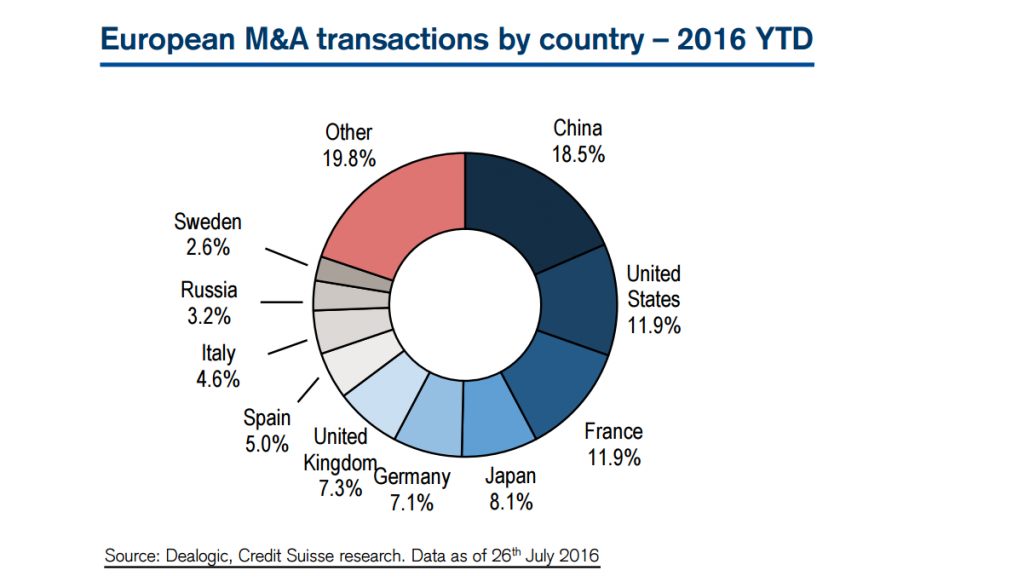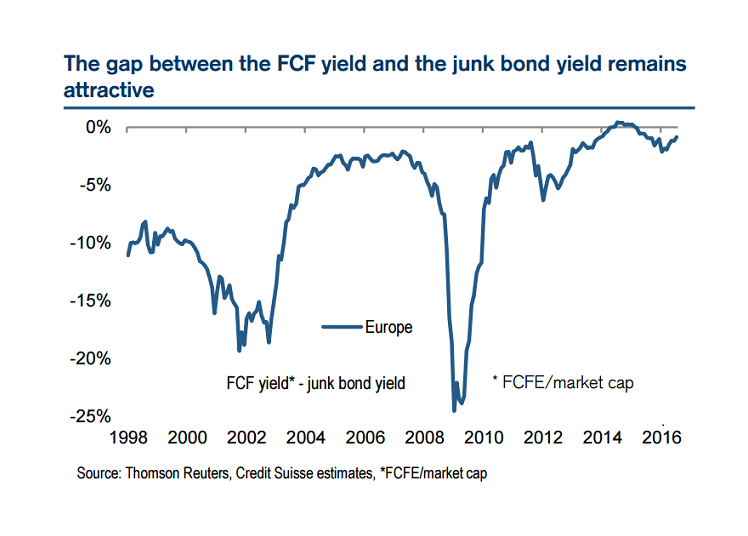It’s not shaping up to be a banner year for mergers and acquisitions in Europe. Deal value totaled about 0 billion as of July 26 and is on track to reach 0 billion by year-end, which will put it some 0 billion short of last year. And parts of the horizon beyond that aren’t exactly compelling, either: A Credit Suisse survey of European executives shortly after the U.K.’s June vote to leave the European Union found that the Brexit shock had already made business leaders more reluctant to spend. What will turn things around? In a word, China. Credit Suisse likes the prospects of a European M&A revival fueled by a country increasingly searching for investment opportunities outside its borders. Chinese firms have spent 4 billion buying non-Chinese firms so far this year, surpassing the total for all of 2015 and already marking a new annual record for the Middle Kingdom before the year is much more than half over. Among European deals this year, 18.5 percent of acquirers have been Chinese, more than any other country. In February, the Swiss pesticide giant Syngenta agreed to a billion takeover by the state-owned Chinese agrochemical company, ChemChina. Why are Chinese companies engaging in a shopping spree when the rest of the world seems in belt-tightening mode? One way to understand it is to understand that it’s not just Chinese companies but China itself.
Topics:
Alice Gomstyn considers the following as important: China, Chinese acquisitions, Europe, European M&A, European mergers and acquisitions, Investing: Features, M&A, mergers and acquisitions
This could be interesting, too:
Marc Chandler writes US Dollar is Offered and China’s Politburo Promises more Monetary and Fiscal Support
Marc Chandler writes French Government on Precipice, Presses Euro Lower
Marc Chandler writes Ueda Lifts Yen, Leaving Euro and Sterling Pinned Near Lows
Marc Chandler writes FX and Rates Unwind Yesterday’s Powell Effect, US Index Futures Slide

It’s not shaping up to be a banner year for mergers and acquisitions in Europe. Deal value totaled about $400 billion as of July 26 and is on track to reach $800 billion by year-end, which will put it some $200 billion short of last year. And parts of the horizon beyond that aren’t exactly compelling, either: A Credit Suisse survey of European executives shortly after the U.K.’s June vote to leave the European Union found that the Brexit shock had already made business leaders more reluctant to spend. What will turn things around? In a word, China. Credit Suisse likes the prospects of a European M&A revival fueled by a country increasingly searching for investment opportunities outside its borders.
Chinese firms have spent $144 billion buying non-Chinese firms so far this year, surpassing the total for all of 2015 and already marking a new annual record for the Middle Kingdom before the year is much more than half over. Among European deals this year, 18.5 percent of acquirers have been Chinese, more than any other country. In February, the Swiss pesticide giant Syngenta agreed to a $43 billion takeover by the state-owned Chinese agrochemical company, ChemChina.
Why are Chinese companies engaging in a shopping spree when the rest of the world seems in belt-tightening mode? One way to understand it is to understand that it’s not just Chinese companies but China itself. Last year, 70 percent of Chinese investment in EU companies and assets came through Chinese state-owned companies, according to a report by the Mercator Institute for China Studies (MERICS), a German think tank. “Chinese investment now takes a top spot on the agenda of major diplomatic occasions as China is eager to counterbalance growing negativism about falling Chinese demand for foreign goods and China’s ballooning trade surpluses,” the report’s authors wrote, adding that Chinese officials are increasingly using “the promise of investment” to influence diplomatic negotiations with the EU.
Credit Suisse observes that there are also clear financial motivations underpinning China’s love affair with European companies. Chinese companies now have the firepower for an international shopping spree thanks to its overvalued currency and a surfeit of cheap capital provided by Chinese banks. Furthermore, as growth inside China’s borders continues to slow, Chinese companies are doing as any company does in their position: they are trying to buy that growth elsewhere. For them, Europe offers a bevy of acquisition targets with relatively low leverage ratios and free cash flow yields high enough to rival those of junk bonds. The weakness of the pound, meanwhile, makes U.K.-based companies particularly appealing.
Industries that rank high on China’s M&A wish list will include travel and leisure, insurance, aerospace and defense, metals and mining, hardware and semiconductors, utilities, capital goods, and entertainment.
Some purchases may be strategically driven in addition to financially so. Credit Suisse believes China’s state-owned tobacco monopoly is likely to seek out European tobacco companies in an effort to leverage their production expertise and to spread Chinese tobacco brands into foreign markets. Chinese manufacturing companies are surely also considering buying entire capital goods firms for the sole purpose of acquiring their automation technology, a step that could help Chinese companies move up the value chain.
But not all Chinese firms will target European companies with equal fervor. Credit Suisse believes industries with low or uncertain potential for new acquisitions by Chinese firms include chemicals and pharmaceuticals, where opposition from European regulators could pose a significant hurdle.
The post Europe’s New M&A Patron: China appeared first on The Financialist.


